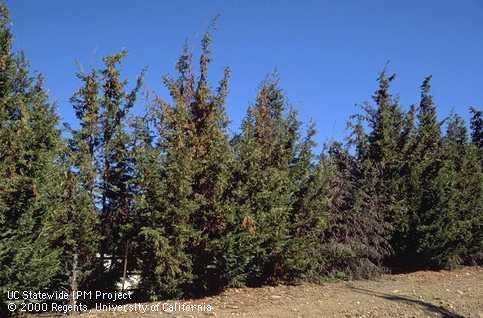There are a number of factors that can set landscapes up for potential disasters and one of these is chronic plant stress. Many trees and shrubs, when exposed to prolonged periods of stresses like drought, are more likely to be attacked by insects or invaded by disease organisms.
As it should be clear by now, we are in a prolonged drought. While many Owens Valley landscapes have been able to maintain consistent soil moisture throughout the drought, others have not been so lucky.
There are two predominant changes common in landscapes that are occurring right now.
- Some yards are being maintained much dryer than in the past
- Some yards are inundated with excess moisture
Drier Yards
In yards that have become more dry, expect issues such as borer infestations and canker diseases. Once either pest has become established, it is very difficult to cure. The best cure in these cases is prevention. Vigorous, growing plants are much less susceptible to pest attacks. By keeping your trees and shrubs in good condition you will avoid most attacks will be able to endure those that do occur.
There is no getting around it: your landscape will continue to need water. It is important if you have less access to water, water what you intend to keep alive deeply. Deep watering will encourage the best possible utilization by roots. Using mulches to moderate soil temperatures and moisture loss is also beneficial.
Local trees we would expect to be most affected by drought-associated pests and diseases will be
- Lelyand cypress
- Arizona cypress
- Poplars, aspens, and cottonwoods
- Pines
- Fruit trees
Wet Yards
Too much of a good thing can also be problematic. Many yards in West Bishop are finding that their soils are inundated with moisture. For plants not acclimated or adapted to those conditions, this can be deadly. Waterlogged soils lack oxygen and the root injury that goes with it can lead to root rots.
If yards continue to be saturated, usually an engineering solution to remove excess sub-surface water, such as French drains, is needed. If this is a temporary condition, perhaps there will be no consequence.
Suggestions
It's hard to make blanket recommendations but here are a few ideas if you find yourself managing a landscape whose moisture level has changed dramatically.
- Water dry plants deeply.
- Use mulch in dry areas near shrubs and trees (but keep an eye open for new pests). Keep mulch off trunks.
- Encourage bare soil on wet yards to increase evaporation. Cool-season grasses will also pull moisture out of the soil, so don't remove lawns in these situations
- Watch plants for signs of change. Catching problems early increases options.
- Start saving for a fund to remove trees. If a tree needs removal, it can be expensive. If you don't ever need it, you'll have a vacation fund instead!
Contact the Master Gardeners for more ideas for dealing with your yard. inyomonomg@ucdavis.edu.
